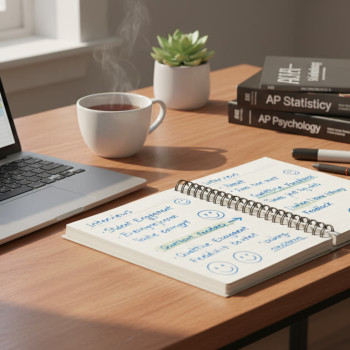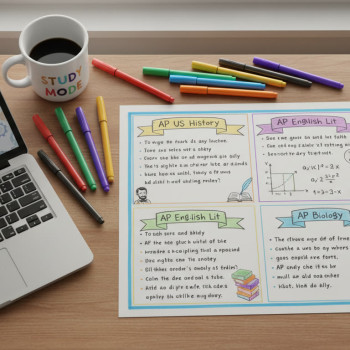Why a Personal AP Practice Test Calendar Changes Everything
There’s studying, and then there’s studying with rhythm, intention, and a plan that reminds you where you’re going. An AP practice test calendar does more than fill in dates on a page — it turns vague “I’ll study later” into a living, breathing roadmap. Whether you’re taking AP Calculus, AP U.S. History, AP Biology, or any other AP course, the right calendar helps you manage content review, practice tests, skill-building, and real rest so you reach exam day ready and calm.
This post walks you through creating a personalized calendar, explains how to choose and schedule practice tests, shows how to track progress with data, and provides templates and examples you can plug into your weekly life. I’ll also point out where one-on-one guidance — like Sparkl’s personalized tutoring, tailored study plans, expert tutors, and AI-driven insights — can make a measurable difference.
Start with the End in Mind: Exam Dates and Milestones
Before you schedule anything, confirm the concrete exam date(s) and any school deadlines. AP Exams are administered nationally in the spring; your school or AP coordinator will post the exact day and time in My AP. When you know the target date, count backward to create time blocks for knowledge, practice, and polish.
Key Milestones to Block on Your Calendar
- Exam Day (absolute anchor)
- Final full-length practice test (1–2 weeks before exam)
- Midpoint diagnostic practice test (about halfway through your prep)
- Weekly practice sessions and topic reviews
- Buffer days for fatigue, school events, and last-minute review
- Performance-check checkpoints (every 2–3 weeks) to adjust plan

Step 1 — Assess Where You Are: Diagnostic and Goals
Start with a realistic diagnostic. This isn’t a quiz to shame you — it’s valuable data. Take a timed, full-length practice exam under as-realistic-as-possible conditions: timed sections, minimal breaks, and the same materials you’ll use on test day. Use your diagnostic to set a target score and stretch goals.
How to Turn Diagnostic Results into Calendar Decisions
- If you’re within 10% of your target score, focus on targeted practice tests and refining weaker question types.
- If you’re 10–20% below target, schedule regular full-length tests plus weekly content blocks to shore up gaps.
- If you’re more than 20% below target, build a longer prep runway and consider 1-on-1 support to accelerate progress.
Step 2 — Decide Practice Test Frequency
Not all practice test strategies are created equal. Frequency should match where you are in the prep cycle.
Suggested Frequency by Prep Phase
- Early prep (3–4 months out): One full-length diagnostic + one targeted practice every 2–3 weeks.
- Mid prep (1–3 months out): One full-length practice every 2 weeks; weekly section or question-bank practice.
- Final phase (last month): One full-length practice each week, plus daily micro-practice (30–60 minutes) on weak areas.
These are guidelines — personalize them to your schedule, energy levels, and academic load. If you have limited time, prioritize quality: well-reviewed, fully-timed practices beat half-hearted test attempts.
Step 3 — Build the Calendar Framework
Your calendar has layers: macro (months), meso (weeks), and micro (days). Think of them like a map, a route, and the step-by-step directions.
Macro Layer: Monthly Blocks
Divide the timeline into three-month (or single-semester) blocks. Each block has an aim: learn, practice, polish.
| Phase | Timeframe | Main Focus | Practice Test Rhythm |
|---|---|---|---|
| Learn | Months 4–6 before exam | Content mastery, vocabulary, core skills | Diagnostic + 1 practice every 2–3 weeks |
| Practice | Months 2–3 before exam | Timed sections, pacing, weak-skill focus | 1 full-length every 10–14 days |
| Polish | Last 4 weeks | Simulated exam conditions, strategy, final review | 1 full-length weekly + micro-practice daily |
Meso Layer: Weekly Plan
A practical weekly template helps you balance classes, extracurriculars, and social life. Aim for 5 focused study sessions a week rather than cramming on weekends.
- 2 content sessions (60–90 min)
- 2 targeted practice sessions (30–60 min) focusing on question types
- 1 longer session (90–120 min) for mixed practice or timed sections
- 1 rest or light review day
Micro Layer: Daily Habits
Consistency is built from daily micro-choices. A 30-minute daily practice can be more effective than an 8-hour weekend study sprint. Use timers, the Pomodoro technique, and single-goal sessions (e.g., “I’ll do 20 AP multiple-choice questions on inference”) to keep sessions pure and productive.
Step 4 — Choose Your Practice Test Materials
Use authentic materials when you can: released College Board questions, AP Classroom resources, and official Bluebook previews if you’re taking a digital exam. Mix in high-quality, teacher-recommended practice where needed.
Types of Practice to Include
- Full-Length Official Practice Exams (timed, strict conditions)
- Section-Level Timed Drills (e.g., 1 free-response set or a 60-minute multiple-choice section)
- Topic Quizzes from AP Classroom and released FRQs
- Mixed Question Banks for pacing and stamina
Step 5 — Track, Analyze, and Adjust
This is where your calendar becomes intelligent. After each practice test, spend time analyzing mistakes. Log the error type, the content area, and whether the mistake was content-based, strategy-based, or careless. Then adjust your calendar.
Simple Practice Test Tracking Table
| Date | Score / Section Breakdown | Top 2 Weak Areas | Action Next Week |
|---|---|---|---|
| Mar 8 | 72% MC, 3/6 FRQ | Statistics, Time Management | 2 extra stats drills, timed MC practice |
| Mar 22 | 78% MC, 4/6 FRQ | Short Answer Pacing | Simulate timed sections twice this week |
Every two weeks, review your log. Patterns will emerge. If you’re consistently missing synthesis questions, carve out focused sessions to practice that exact skill. If pacing is an issue, add more timed section practice to your weekly schedule, not just full tests.
Step 6 — Build Realistic Practice Test Days
A realistic test day sim is invaluable. When you take a full-length practice, replicate exam conditions as closely as possible: start time, breaks, allowed materials, and even the environment (quiet room, similar lighting). That trains not only skills but also mindset.
Checklist for a Realistic Test Simulation
- Set strict start/end times and use a visible timer.
- Prepare permitted materials in advance.
- Simulate breaks exactly as the real exam provides.
- Avoid interruptions: tell family/housemates or use headphones.
- Post-test: do a careful error analysis session (30–60 minutes).
Using Technology and Tools to Automate Your Calendar
Use calendar apps, reminders, and task managers to automate repetition. Create repeating events for weekly drills, mark practice-test dates far in advance, and set intermediate reminders for prep tasks like downloading practice materials or reviewing scoring guidelines.
Tools That Fit Naturally
- Digital calendar (Google Calendar, Apple Calendar) with color-coded events
- Spreadsheet tracker for scores and error types
- AP Classroom for course-specific practice and progress checks
- Bluebook app test previews (for digital exams) to demystify format
For students who want a more guided experience, Sparkl’s personalized tutoring can be slotted into your calendar as recurring 1-on-1 sessions. Their tailored study plans and AI-driven insights can help interpret practice-test data and recommend which items to slot into your weekly plan.
Sample 12-Week Practice Test Calendar (Example)
The following sample assumes an exam in Week 12. Adjust durations depending on when you start.
| Week | Focus | Practice Tests | Weekly Habit |
|---|---|---|---|
| 1 | Diagnostic + Set Goals | 1 diagnostic (full-length) | 4 content sessions |
| 2 | Core Content Review | Section-level timed drill | Topic drills twice |
| 3 | Skill Practice | 1 full-length (review deeply) | Analyze errors, tutor check-in |
| 4–7 | Mixed Practice and Weak-Area Focus | 1 full-length every 2 weeks | Weekly timed sections, nightly micro-practice |
| 8–10 | Simulate Exam Conditions | Full-length every 10 days | Review scoring rubrics and FRQ techniques |
| 11 | Final Review | 1 full-length (2 weeks out) | Polish weak skills, get sleep schedule aligned |
| 12 | Exam Week | Light micro-practice only | Rest, logistics, confidence-building |
When and How to Bring in Personalized Help
Personalized tutoring is particularly useful when diagnostics show stubborn plateaus, when content gaps are deep, or when you need accountability. A tutor can watch you take a practice test, analyze your errors live, and help you implement targeted changes to your calendar so time is spent where it matters most.
The Right Time to Use 1-on-1 Support
- After two practice cycles with little improvement
- If you’re balancing multiple APs and need a prioritized plan
- When you want a tailored practice-test cadence that fits your extracurricular schedule
- If you’d like data-driven adjustments to your calendar — for example, scheduling extra timed sections instead of more full-length exams
Services like Sparkl can slot into the calendar as weekly check-ins or intensive weekend sessions. Their tutors help translate practice-test data into focused weekly tasks — for many students that’s the difference between steady improvement and stagnation.
Common Pitfalls and How to Avoid Them
Here are mistakes students make when building a practice-test calendar and practical fixes.
Pitfall: Too Many Full Tests, Not Enough Focused Practice
Fix: Replace every other full-length with targeted section practice that addresses your most frequent error types.
Pitfall: Ignoring Timing and Pacing
Fix: Schedule at least one timed-section session per week in the mid-prep phase, and increase to two in the final month.
Pitfall: Treating Practice Tests as Checkboxes
Fix: Dedicate the same amount of time to analysis after the test as you spent taking it. Score patterns tell a story; reading it is non-negotiable.
Last Two Weeks — Taper Strategically
The final two weeks are about consolidation, not new learning. Reduce heavy content intake. Keep doing full-lengths early in this period, then taper to lighter and more strategic practice as the exam nears.
Final Week Checklist
- Confirm exam logistics: location, start time, permitted materials
- Prepare a small kit (ID, pencils, approved calculator, water)
- Sleep schedule: align bedtime so you’re alert at the exam hour
- Light review of formulas, vocabulary, and rubric notes
- Mental prep: breathe, brief visualization, and positive routines

Putting It All Together: A Personalized Calendar Template
Here’s a compact template you can copy into your digital calendar or planner. Adjust times and frequency to match your school load and energy.
- Monday: Content review (90 min) — focus on one major unit
- Tuesday: Targeted practice (45 min) — question bank specific to weak topic
- Wednesday: Mixed practice (60 min) — timed section
- Thursday: Light content + review errors (45 min)
- Friday: Rest or light 30-min recap
- Saturday: Longer session (120 min) — alternate between full-length and mixed sections
- Sunday: Analysis and planner session (60 min) — log mistakes and schedule next week
Final Thoughts: Your Calendar Is a Living Tool
Building a personal AP practice test calendar is less about rigid schedules and more about consistent, intelligent effort. The calendar should respond to your data: if your practice logs show a persistent weakness, bend the calendar toward fixing it. If you’re on an upward trajectory, keep the momentum with strategic practice.
Remember: practice tests aren’t punishments — they’re the clearest, most honest feedback loop you’ll get. Treat them as experiments: make a hypothesis (“If I practice timed FRQs twice a week, my FRQ score will increase”), test it, measure the results, and iterate.
Need a Hand Making It Personal?
If you want this calendar tailored to your exact courses, schedule, and goals, consider integrating one-on-one guidance. Personalized tutoring services like Sparkl offer tailored study plans, expert tutors, and AI-driven insights that can turn your practice-test data into weekly actions — and give you accountability when life gets busy. A few smart sessions can save you countless ineffective study hours.
Your Next Steps
- Lock your exam date and count backward to create a 12-week plan (or longer if needed).
- Take a diagnostic full-length test this week.
- Use the template here to build repeating weekly events in your calendar app.
- Log every practice test and analyze your errors for 30–60 minutes afterward.
- Adjust frequency of full-lengths and section practice based on data, not panic.
You’ve got this. With a clear calendar, honest diagnostics, and focused practice, AP success becomes a series of small, confident steps rather than a last-minute sprint. Keep your plan visible, be kind to yourself on tough days, and iterate often. If you ever want help translating your practice-test data into a week-by-week calendar, a personalized tutoring session can speed the process and sharpen the outcomes.
Parting Thought
Think of your AP calendar as a rehearsal schedule for your best performance. Actors, athletes, and musicians don’t wing opening night — they rehearse with feedback, timing, and pacing. You’re doing the same with your learning. Schedule those practice tests, analyze them honestly, and give yourself the structure to perform at your best on exam day.

















No Comments
Leave a comment Cancel